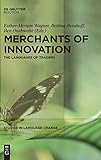Merchants of Innovation : The Languages of Traders / ed. by Esther-Miriam Wagner, Bettina Beinhoff, Ben Outhwaite.
Material type: TextSeries: Studies in Language Change [SLC] ; 15Publisher: Berlin ; Boston : De Gruyter Mouton, [2017]Copyright date: ©2017Description: 1 online resource (VIII, 275 p.)Content type:
TextSeries: Studies in Language Change [SLC] ; 15Publisher: Berlin ; Boston : De Gruyter Mouton, [2017]Copyright date: ©2017Description: 1 online resource (VIII, 275 p.)Content type: - 9781501511608
- 9781501503412
- 9781501503542
- 418.0071 23
- P120.M47 M47 2017
- P51 .M473 2017
- online - DeGruyter
- Issued also in print.
| Item type | Current library | Call number | URL | Status | Notes | Barcode | |
|---|---|---|---|---|---|---|---|
 eBook
eBook
|
Biblioteca "Angelicum" Pont. Univ. S.Tommaso d'Aquino Nuvola online | online - DeGruyter (Browse shelf(Opens below)) | Online access | Not for loan (Accesso limitato) | Accesso per gli utenti autorizzati / Access for authorized users | (dgr)9781501503542 |
Frontmatter -- Acknowledgements -- Contents -- I. Introduction -- 1. Merchants of Innovation: the languages of traders -- II. Literacy of traders and their agency as linguistic trendsetters -- 2. Like the coins when currencies are combined: contextualizing the written language of fifteenth-century English merchants -- 3. Bridges of innovation and change: the English language around the networks of the Mercery of London -- 4. The socio-linguistics of Judaeo-Arabic mercantile writing -- III. Code-switching, loanwords and multilingualism -- 5. Business writing in early sixteenth-century Norway -- 6. Kiss Me Quick: on the naming of commodities in Britain, 1650 to the First World War -- 7. The early English East India Company as a community of practice: evidence of multilingualism -- 8. Language choice in forming an identity: linguistic innovations by German traders in Bergen -- 9. From the synagogue to the market square: cardinal numbers in Older Yiddish -- IV. Mercantile linguistic communities -- 10. Early Anglo-Italian contact: new loanword evidence from two mercantile sources, 1440–1451 -- 11. Multilingual merchants: the trade network of the 14th century Tuscan merchant Francesco di Marco Datini -- 12. On a famous lacuna: Lingua Franca the Mediterranean trade pidgin? -- Index
restricted access online access with authorization star
http://purl.org/coar/access_right/c_16ec
Traders around the world use particular spoken argots, to guard commercial secrets or to cement their identity as members of a certain group. The written registers of traders, too, in correspondence and other commercial texts show significant differences from the language used in official, legal or private writing. This volume suggests a clear cross-linguistic tendency that mercantile writing displays a greater degree of language mixing, code-switching and linguistic innovations, and, by setting precedents, promote language change. This interdisciplinary volume aims to place the traders' languages within a wider sociolinguistic context. Questions addressed include: What differences can be observed between mercantile registers and those of court or legal scribes? Do the traders' texts show the early emergence of features that take longer to permeate into the 'higher' varieties of the same language? Do they anticipate language change in the standard register or influence it by setting linguistic precedents? What sets traders' letters apart from private correspondence and other 'low' registers? The book will also examine bilingualism, semi-bilingualism, reasons for code-switching and the choice of particular languages over others in commercial correspondence.
Issued also in print.
Mode of access: Internet via World Wide Web.
In English.
Description based on online resource; title from PDF title page (publisher's Web site, viewed 25. Jun 2024)


